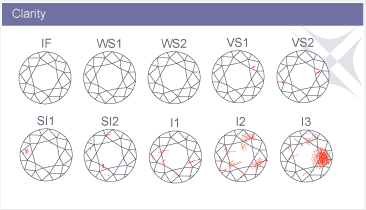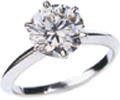Loose Diamonds
Diamond Guides
- The 4 C's and More
- Diamond Shape
- Diamond Cut
- Diamond Color
- Diamond Clarity
- Diamond Carat Size
- GIA Certification
- GIA Cut Grades
Jewelry Guides
- Engagement Ring Guide
- Diamond Tips
- Caring For Your Jewelry
- Tips on Getting Her Ring Size
- How To Build Your Fine Diamond Jewelry Wardrobe
- Diamond & Jewelry Appraisals
- Branded Diamonds
Education Videos
Design Your Engagement Ring
A. Fishman Difference
- Direct Diamond Prices
- Loose Diamond Manufacturer
- A+ Rating From BBB
- Customer Testimonials
- 100% Money Back Guarantee
- FREE FedEx Overnight Shipping
- Lifetime Warranty
- 2% Discount for Bank Wires
- Why No "Shopping Cart"
Expert Guidance
- Expert Guidance
- 212-869-0085
Understanding Diamond Clarity
Diamond Clarity is a combination of how many inclusions occur within a diamond and how noticeable they are. Most diamonds contain blemishes on the outside of the diamond or inclusions trapped inside the diamond. These inclusions are what distinguish a single diamond from every other diamond.
Factors to Consider
While determining the diamond's clarity grade the following are considered:
- Size - How small or large is the inclusion?
- Position - Where in the stone is the inclusion?
- Color - How light or dark is the inclusion?
- Number - How many inclusions are there in the diamond?
- Relief - How thick or thin is the inclusion?
- Nature - What type of inclusion is it?
Please note that, especially in the VS and SI grades, there may be large differences in the actual clarity of two diamonds which are graded the same. The nature and location of the inclusions may make one diamond desirable and another very undesirable. Watch our video to learn more.
Diamond Clarity Chart
Diamond Clarity grading scale ranges from flawless for a perfectly clean diamond under a 10-power microscope to an Included 3 stone where the diamond is so full of inclusions it is both ugly and breakable. The cleaner the diamond the rarer and more expensive it will be.
| Clarity Grade | Description |
| FL Flawless |
No internal or external flaws |
| IF Internally flawless |
No internal flaws; slight external blemishes |
| VVS1, VVS2 Very very slight inclusions |
Extremely difficult for a professional to see under 10X magnification |
| VS1, VS2 Very slight inclusions |
Very difficult to see under 10X magnification |
| SI1, SI2 Slight inclusions |
Easy for a professional to see under 10X magnification. NOTE: SI3 is not a valid GIA clarity grade. A. Fishman & Son owns only GIA certified diamonds so you will not find SI3 clarity grades in our inventory. Any diamond graded SI3 by other laboratories will get I1 or I2 clarity grades from the GIA and those diamonds will have inclusions which will be visible to the naked eye |
| I1, I2, I3 Inclusions |
Inclusions that can be easily visible to the naked eye. I2 and I3 clarity grade diamonds can be dangerous and subject to breakage |
| A. Fishman will not sell you a diamond with a clarity grade lower than I1. | |
An Example of the Different Clarity Grades:

What Clarity Grades Should You Buy?
We recommend that you select an "eye-clean" diamond — one that has no inclusions visible to the unaided eye. An excellent value, diamonds of this clarity are much less expensive than IF- or FL-grade diamonds and typically do not contain visible inclusions that detract from the beauty of the diamond. If you're considering an SI grade diamond, call to speak to Josh Fishman who will review the diamond to ensure the inclusions are not visible with the unaided eye. Remember that other sellers, like BlueNile, cannot really tell you about their listed diamonds because they don't own them and they don't have instant access to them. But, if you'd rather not compromise on clarity yet are budget conscious, choose a diamond with a good cut and G to J color.
Not all Clarity Grades are Created Equal
Like other elements of the 4 C's, Clarity seems like a simple subject. But it is very complex. The nature of the inclusion in a diamond may make a lower graded diamond more desirable than a higher graded diamond. Read the articles noted below and watch the video included above to get a more complete understanding of this very crucial "C" of the 4 C's!
Understanding Diamond Clarity Enhancements
As this is a very important subject, I have devoted a full page to this subject. Please click on Clarity Enhancement of Diamonds to read a full discussion of this topic.
Loose Diamonds
Shapes of Diamonds
Diamond Videos-New
About our Loose Diamonds
Perfect Diamonds
Pretty Diamonds
Round Cut
Princess Cut
Cushion Cut
Radiant Cut
Emerald Cut
Asscher Cut
Pear Shape
Oval Shape
Marquise Shape
Heart Shape
Diamond Jewelry
Brooches
Bracelets
Earrings
Engagement
Necklaces and Pendants
Wedding Rings
Custom Designed Jewelry
Diamond Guides
Diamond Guide - The 4 C's
Ethics of Lab-Grown Diamonds
Purchase: Beyond the Four C's
Diamond Guide Videos
Engagement Ring Guide
Understanding GIA Certificates
Understanding GIA Cut Grades
Pretty Diamonds
Diamond Clarity Enhancements
Conflict Free Diamonds
Identifying Fake Diamonds
Diamond Tips
Diamond Jewelry Appraisals
Diamond & Jewelry Care
Gift Giving
Beyond the 4 C's
Jewelry and Diamonds to Wear for a Lifetime - Not Just a Season!™
 A. Fishman & Son • 580 Fifth Avenue, Ste 402 • New York, NY 10036 • 212-869-0085
A. Fishman & Son • 580 Fifth Avenue, Ste 402 • New York, NY 10036 • 212-869-0085
Copyright © 2011-2022 A.Fishman & Son. All Rights Reserved. Website by YLWConsulting




